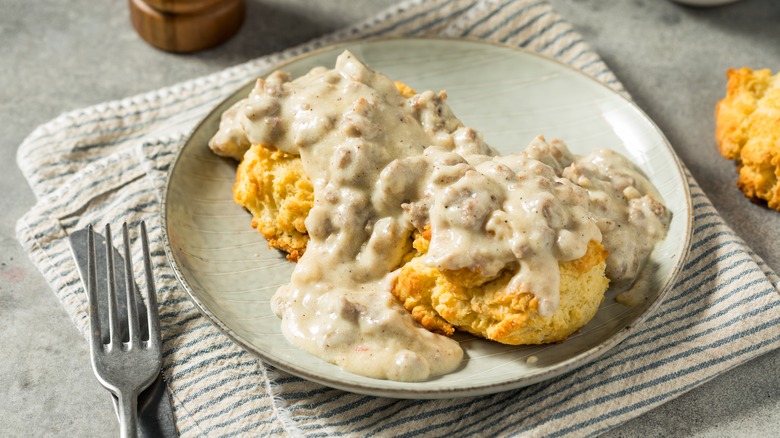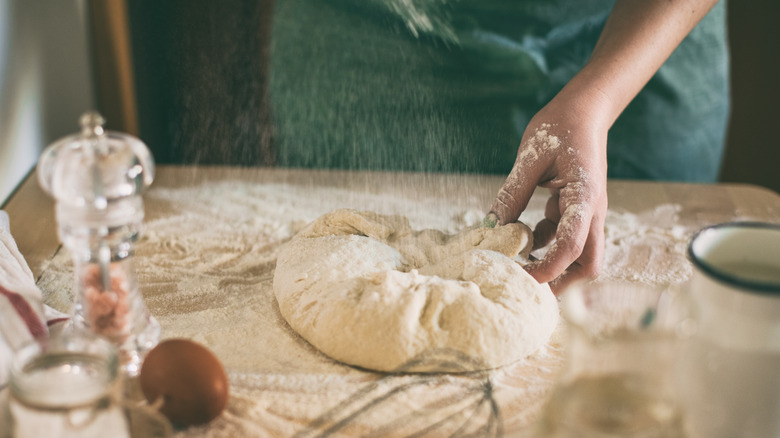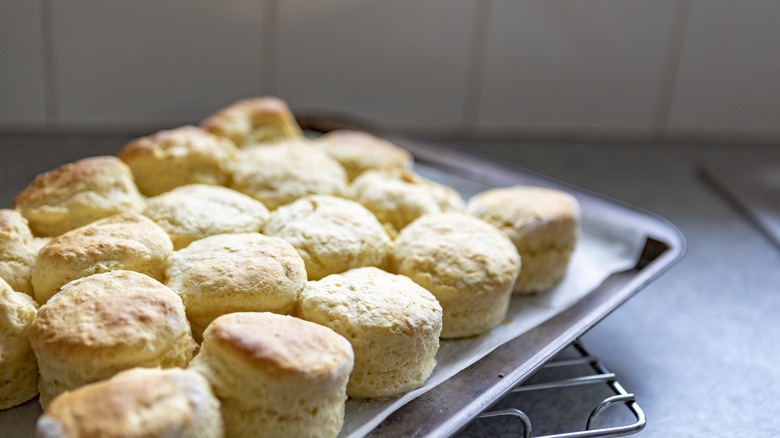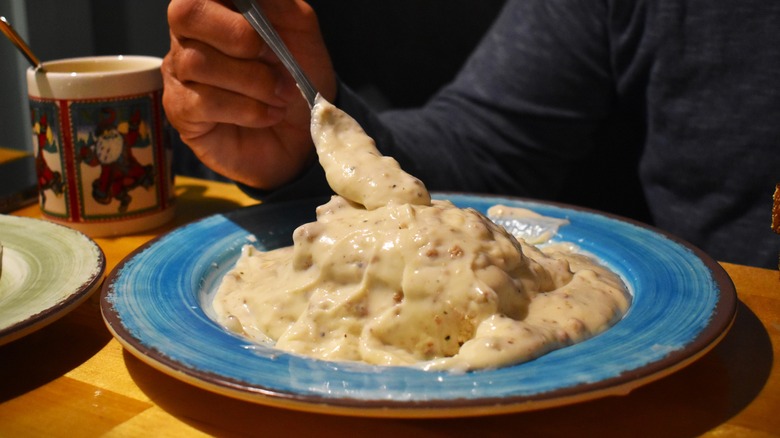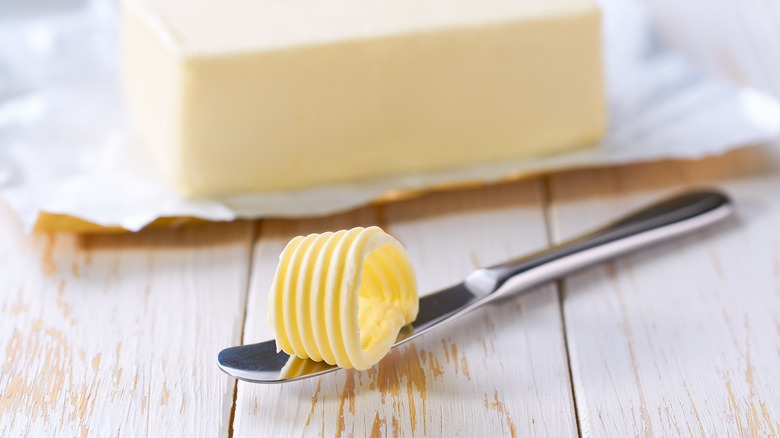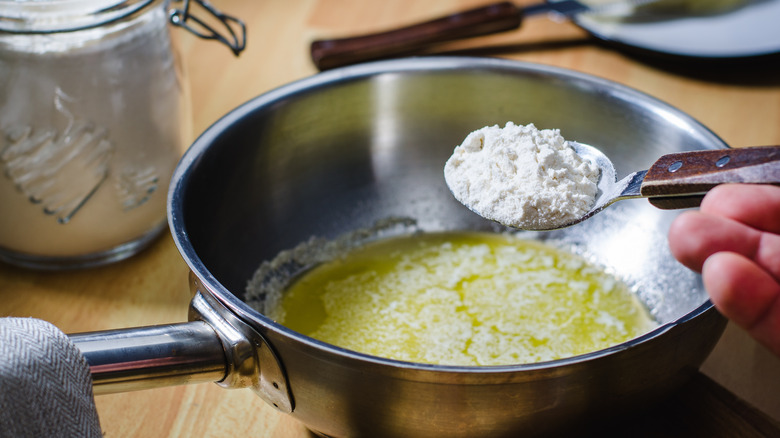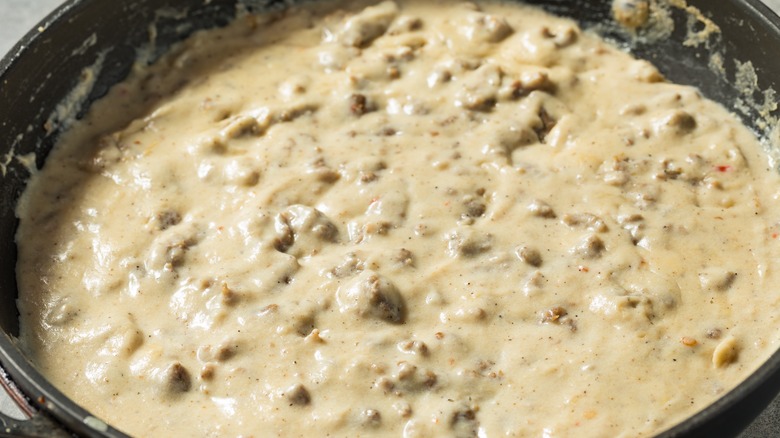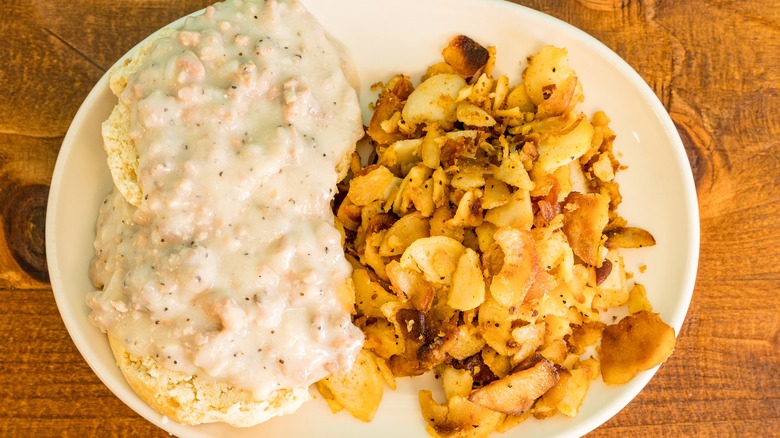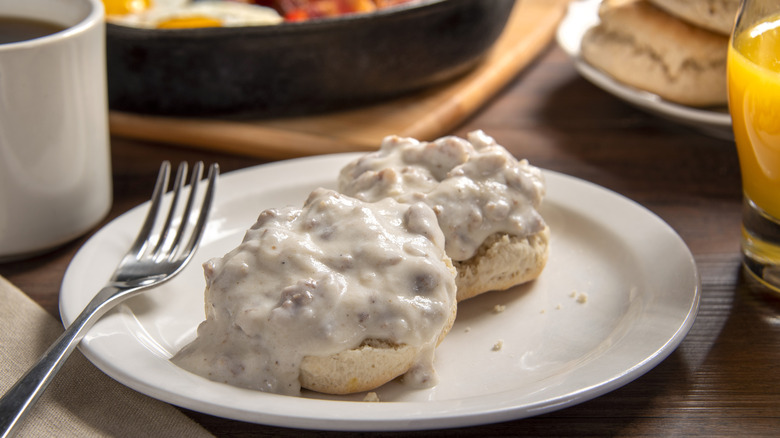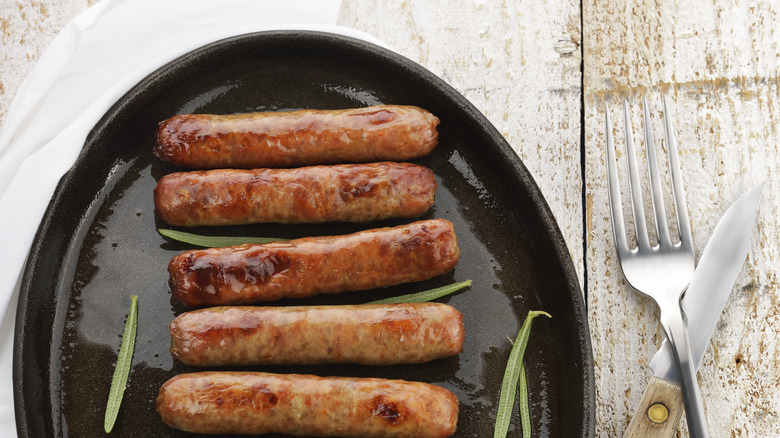How To Make Restaurant-Quality Biscuits And Gravy, According To Experts
Emerging out of Appalachia as a thrifty meal to satiate the labor class, biscuits and gravy is today considered a classic breakfast dish. Plush, golden biscuits smothered in waterfalls of sausage gravy permeates American diners and holes-in-the-wall, with the plate considered a signature at fast-food spots like Hardee's. Yet perhaps the bee in your bonnet has struck to try and whip it up yourself. You think "it's easy enough" and purchase all the ingredients. With knife-and-fork in hand, ready to taste the fruits of your efforts, you realize it's nothing like the version you order all the time at your favorite restaurant — nothing like it at all. What gives?
It's true that biscuits and gravy is a relatively simple recipe. The comforting combination is humble, and certainly far from intimidating in the grand scheme of culinary matters. But maybe your attempts are in need of a tune-up. We spoke to experts Karl Worley, co-founder of Nashville's Biscuit Love, and pastry chef April Franqueza from High Hampton Resort in Cashiers, North Carolina, who graciously dished out advice for home cooks wanting to boost their B&G game. Between excellent baking tips, seasoning recommendations, and the inventive twists they're putting on the traditional meal, there's numerous ways to bring your biscuits and gravy plate to the next level. So grab some napkins and your comfiest pair of eating pants — it's time to get cooking!
Chefs use the highest-quality ingredients
Gathering top-of-the-line ingredients is the first step to making restaurant-quality biscuits and gravy in your own kitchen. This is a comfort dish that's heavy on richness, and explains why you'll never see professional chefs skimping and choosing processed substitutes as stand-ins for the real thing — margarine in lieu of real butter, for example, or even fresher, premium varieties of sausage. Additionally, seasoned cooks are going to have access to suppliers who are exclusive, and quite often, out of reach for the average grocery shopper.
Biscuit Love's sausage, per Karl Worley, is custom-produced to retain more fat, thanks to livestock sourced exclusively to the restaurant. But manning your own farm isn't a prerequisite to unlock Southern-style mastery at home. According to experts, home cooks have many possibilities on their plate for tracking down professional-grade wares, and it won't always require a lot of work. Consider provisions that can be sourced locally to you. Make an effort to only get your meat from the butcher, since the selection is curated, and offers the convenience of on-site expertise from behind the counter. Worley scores his sausage from Bear Creek Farm in Tennessee, and April Franqueza enjoys South Carolina-based Snow Creek for its meat variety.
Handle the biscuit dough lightly for the best texture
A delicious biscuits and gravy recipe always features a spot-on biscuit — and that goes for just about any dine-in restaurant on earth. Even if you're smothering them in luscious creaminess, biscuits should be flaky and flush with the most delicate layers. This leads to our next step of unlocking biscuits on par with a great-great-great Southern grandma: handle the dough as lightly as possible. When it comes to the dining industry's top practitioners, knowing when to step away from the kneading is a sign that a veteran cook has mastered the B in B&G. "When making and baking biscuits, it's important to not overwork the dough," says April Franqueza. "It will be a shaggy, messy, mass, but if you try to keep kneading it together, you will end up with very tough biscuits."
Essentially, you want to flatten the dough until the outer surface is smooth. Carla Hall, in a demo for Food Network, gently presses the dough down with her fingers, flipping on each side in order to preserve the buttery layers that will rise further in the oven. Franqueza echoes this technique, explaining how at High Hampton, "We toss all of the ingredients together, mixing by hand, and then fold the dough onto itself to help 'laminate' in some layers, giving you a fluffy, flaky, and crispy end result."
Make the biscuits from scratch
Something else that separates the pros from average home cooks? Opting to make their biscuits from scratch. Any comfort food establishment prized for biscuits and gravy is bound to bake homemade biscuits, better yet often developing the recipes by hand. There's a bit of a learning curve to baking these beauties correctly, especially if you've never prepared them beyond Pillsbury rounds sold at the grocery store. Still, you'll be surprised that the core task of biscuit-making is incredibly low-stakes, requiring little more than a handful of dry and wet essentials, such as flour, leavening agents, and liquid dairy. "In my opinion, there should be nothing overcomplicated about making biscuits," reveals April Franqueza. "Our recipe is so simple, and since we make it every day, I can recall it from memory."
Admittedly, newbies might need a little practice to nail the basics of this bread roll. But as Karl Worley assures us, mistakes are bound to happen when handling a raw dough ball. And thankfully, the cost is pretty low if a batch doesn't go as successfully as planned, so there's no need to fret should your dough take a wrong turn. From his perspective, "Typically it's only a few dollars of ingredients, so you can throw it away and start over."
They've perfected biscuits and gravy through practice
Cooking is a profession, and when chefs are accomplished in their skills, they crank out dishes possessing unwavering consistency. Without any doubt, this notion is the defining cornerstone of expertise — the method of routinely performing a set task until the results reflect success. Your local greasy spoon, against the ordinary setting that is your kitchen, is probably hard to top on the B&G precisely with this consideration in mind. The experts in our midst have invested never-ending time and energy adapting their skills to improve the dish, ensuring each guest who swings through for a bite is treated to a plate that's better than the last. It's proof that hard work — the practice — ultimately paves the way for immaculate Southern goodness.
April Franqueza's biography on High Hampton's website certainly attests to the pastry specialist's efforts being long term in duration. Still, you don't need to have a head start to hone your biscuit, or gravy-making craft. Simply put, testing yourself with a B&G recipe of choice — and making it again and again — can help you reach, or get close to, an expert's level.
Chefs advise cooking the sausage in butter
Browsing biscuit and gravy demos from a variety of experts, one is usually bombarded with similar, albeit diverging tips. Cooking the sausage, for instance, typically leads home cooks to be told to use extra fat, and of animal origin, most notably bacon grease or lard. But there's no need to fry up a pan so long as you have regular butter on hand. As April Franqueza explains, additional fat is somewhat obsolete when you're already using a protein that harbors plenty of oil on its own. Sizzling it, you'll get the drippings, and those drippings will merge with the dry and wet ingredients of your gravy. "You will cook the sausage first, then make a roux with flour, then add the dairy, so no extra fat is needed," says Franqueza.
True, not all breakfast sausage is ground equally (we have a ranking to back that up). But as long as the oil coats your skillet well, experts aren't keen to richen it up with much more than butter. Simply throw the sausage in the pan, and when browned, toss in the butter, allowing it to melt and coat the meat.
For the gravy, seek out dairy that's high in fat
Besides signifying high standards from a production angle, full-fat dairy is also critical to executing the dish's characteristic richness. A plate of biscuits and gravy never fails to stick to the ribs, and median home cooks should resist the temptation to add fat-free creamer when shopping at the supermarket. Southern-style gravy has some traditional factors to consider, but it's also driven by science. Heavier fat is simply superior to lending your gravy a sumptuously thick texture.
Karl Worley is a proponent of everyday ingredients like half-and-half — AKA, equal parts milk and cream — to draw together Biscuit Love's sausage gravy. As he tells us, the mixture's thicker character does a great job of helping the gravy achieve the right consistency. Meanwhile at April Franqueza's stomping ground High Hampton, you'll find the pastry chef simmering together whole milk and heavy cream, in order to lend the gravy nice body and depth.
On how dense the gravy should be, that's a matter of preference, and different choices will do a different job. You can take Franqueza's recommendation depending on your style: "If you like a thinner gravy, I say opt for more milk, but if you prefer a thicker gravy, heavy cream is the way to go!"
You must cook the roux thoroughly
The biggest roux mistake you're making that's holding back your efforts every time you step to the pan? It involves undercooking the flour. This starch is necessary in forming the gravy, where it simmers into an oozing, caramelized mixture with the aid of the butter and charred bits of cooked sausage (this is also known as deglazing the pan). If you find your taste buds are greeted to a powdery sensation, consider that your roux didn't get a chance to fully incorporate on the stove. Give it a few generous stirs, scraping in any unmixed pockets of flour and letting it darken in color.
Even pointers as meager as this are beneficial to attempting this Southern staple the proper way. Simple as it is to assemble biscuits and gravy, elevating it to the status of restaurant quality is an entirely different beast. It's a matter of fact that expert chefs are attuned to the minutia of any recipe, which means detecting when an element is off. This is how you reach the caliber served in brunch joints.
How to avoid gluey gravy
Whatever your textural leanings, one can expect that sausage gravy, at its baseline, will retain a viscous consistency. Newcomer cooks hoping to DIY a suitable version might wonder, then, why theirs isn't turning out like the diner in town — it could be too thick. "When making your gravy, ensure that you add the flour first to the browned sausage, stirring consistently, then adding the milk a little at a time," instructs April Franqueza. "If you reverse the order and accidentally put milk first and then flour, you will have a lumpy mess." Chronology is critical. Dry ingredients should always go before wet ingredients, never the other way around.
Another tip to keep your gravy sultry, not gluey? Don't overdo the flour in your roux. According to Damaris Phillips, the sauce should slowly thicken after the liquid is added. And speaking of liquids, feel free to add more as needed. As it's simmering, splash some extra milk or cream (basically whatever dairy product you were already using) into the pan if it starts to coagulate. Of course, scalding can be prevented by adjusting the heat on your stove.
Explore seasoning that appeals to your palate
Black pepper — hearty, rigorous shakes of it — remains crucial to defining the savory tone of a classic Southern sausage gravy. In traditional circles, the seasoning would stop there, short of tossing in salt to regulate and bring balance to the herb-y qualities of the meat. Yet authorities across the restaurant industry, as it turns out, aren't stopping there. Seasonings are personal, and the basic salt-and-pepper template is routinely tweaked by chefs to reinforce the aromas and flavors that appeal to their sensibilities.
Spice is an attractive element for injecting some contrast to the creamy gravy. April Franqueza reveals, "If I don't use hot sausage, I love to add red pepper flakes to my gravy for some heat." Similarly, Karl Worley is a huge fan of herbs for infusing the dish with nuanced notes, though he admits that Biscuit Love's seasoning formula (which he devised exclusively for the establishment) retains a more traditional profile. The key variety? Dalmation sage, which is "a rubbed sage which has a bit more of a punch to it."
Obviously, cooking with spices can be a dicey task. You don't want bland gravy, nor is only tasting cayenne desirable either. So make like a professional and discover those winning combinations — it's trial and error.
It's OK to customize the dish to your liking
Focusing on the do's and don'ts of preparing biscuits and gravy is our aim. What often gets lost in the sauce, so to speak, is how immensely adaptable dishes like it can be. Plenty of the guiding principles can often be non-negotiable (the roux, for starters), yet the formulas used by expert chefs to craft both components of the entree? They enjoy a lot of wiggle room. In some areas, it's okay to reject rigidity by going with the flow. "For me," says April Franqueza, "I like a recipe that is simple and that can be interpreted as I'm cooking."
Following instructions to a tee is another area where bakers can use some discretion. Bomb Biscuit Co. founder Erika Council, for example, told King Arthur Flour that on the biscuit front, quantities presented in a single recipe may need tweaking to better suit the specific ingredients being utilized by the baker.
Consider your own tastes as the guidebook. A runnier gravy, a cakier biscuit, even the ratio of spices can present avenues for distinguishing your plate from the rest. And you might recall, professional restaurants are all about finding ways to shine next to its peers.
Some cooks like to experiment with their biscuits and gravy
Much like our point above about seasoning, it's common to witness professional chefs implement new ideas into a longtime breakfast favorite. They've been trained to consider culinary matters from a multitude of angles, with extensive experience pairing components to exciting, mouthwatering ways. In an amateur's quest to make restaurant-quality biscuits and gravy, encountering deviations from the playbook can provide a hit of inspiration, despite extraneous twists remaining a bit taboo among purist-types.
"I think there are lots of ingredients that could be added to sausage gravy that would make it even more delicious," says April Franqueza. "In the springtime, I'm thinking morel mushrooms or even some ramps would really give it zing." Outside the restaurant, you'll find Karl Worley likes to break out zesty alternatives to the default sweetness of breakfast sausage: "At home, I will experiment with different types of sausage such as chorizo sausage." Some of the best restaurants in the U.S. will give the biscuits some razzle-dazzle, as is the case with the cheddar-scallion combo famously used by Lucky's Cafe, a Cleveland institution.
Cooking biscuits and gravy doesn't have to be a challenge
Unlike other culinary specialties, biscuits and gravy isn't knocked for its lack of complicated steps or procedures. It is supposed to be, and is designed to be, as no-frills as it can possibly be. That's why, when attempting it in your home kitchen, you should take the pressure off yourself. Erika Council called biscuits "the people's food," and biscuits and gravy by extension is a dish for everyone, regardless of abilities. You might be surprised by how many experts simplify the process when serving it to their guests.
"Find an easy recipe you feel comfortable with," Karl Worley recommends to any first-time cooks, taking the pains to specify that the formula should be "not so complicated that you're not going to try it." The way we see it, you can only take your plate to the next level when there's a plate in front of you to judge, scrutinize, and critique. And even then, cutting yourself some slack is very much a necessity when you, say, simmer the gravy too long or bake the biscuits far too generously in the oven.
Breakfast sausage is the key to classic biscuits and gravy
Unless a dining establishment says otherwise, you're probably tasting breakfast sausage in your country gravy. The meat (usually pork), is sweeter and imbued with mellow tones, since traditionally, the meat is seasoned with herbs — thyme, fennel, and sage being some of the big ones — and brown sugar or maple syrup for a honeyed feel. Together, these aromas lend a pleasant counterpart to the gravy. The herby qualities complement the peppery sensibilities coming through the dish.
On making restaurant-grade biscuits and gravy, Karl Worley champions breakfast sausage in particular, "because typically it is heavier on sage." Serious Eats' J. Kenji Lopez-Alt also recommends breakfast sausage for its specific flavorings (though he acknowledges cooks outside the U.S. will have to do the seasoning part themselves). Patties and links are acceptable, as well as ground pork sausage you can doctor up with whatever ratio of seasonings you prefer. Substitutes to breakfast sausage are definitely not off-limits, as our experts will touch on later. But if you consider yourself inexperienced to the dish's stylings (that's understandable) play it safe.
